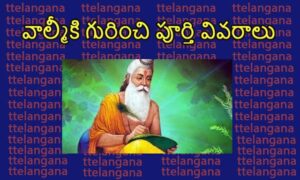Complete details about Valmiki
Valmiki is a revered Hindu sage and poet who is regarded as the author of the epic Ramayana. He is one of the most celebrated figures in Indian history and is believed to have lived during the Treta Yuga, which is considered to be the second of the four Yugas (eras) in Hindu cosmology. Valmiki’s work is revered in Hinduism and is regarded as one of the greatest literary works of ancient India.
Early Life of Valmiki
The life of Valmiki is shrouded in mystery, and not much is known about his early life. According to the legend, Valmiki was a hunter who used to kill birds and animals for his livelihood. Once, while chasing a bird, he heard the voice of a sage reciting a couplet in the Shloka meter. Valmiki was so enchanted by the couplet that he was inspired to compose poetry himself. It is said that he went into a trance-like state and was able to create poetry spontaneously. This experience transformed him from a hunter to a sage and poet.
Meeting with Narada
After his transformation, Valmiki became a disciple of Narada, a revered sage in Hinduism. Narada is believed to have taught Valmiki the art of storytelling and poetry and inspired him to write the Ramayana. It is said that Narada instructed Valmiki to meditate on the name of Lord Rama, the protagonist of the Ramayana, and to compose the epic poem in his honor.
The Composition of the Ramayana
Valmiki’s masterpiece, the Ramayana, is a narrative poem that tells the story of Rama, the prince of Ayodhya, who is exiled from his kingdom and goes on a quest to rescue his wife, Sita, who has been abducted by the demon king Ravana. The Ramayana is divided into seven chapters, known as kandas, and consists of over 24,000 verses.
The first chapter of the Ramayana, known as the Bala Kanda, describes the early life of Rama and his brothers, and their education under the guidance of sage Vishwamitra. The second chapter, the Ayodhya Kanda, describes the life of Rama in Ayodhya, his marriage to Sita, and his subsequent exile. The third chapter, the Aranya Kanda, describes Rama’s life in the forest, his encounter with the demon Surpanakha, and the abduction of Sita by Ravana. The fourth chapter, the Kishkindha Kanda, describes Rama’s alliance with the monkey king Sugriva, and the search for Sita. The fifth chapter, the Sundara Kanda, describes the events leading up to the final battle between Rama and Ravana, including the meeting between Rama and Hanuman, the monkey god. The sixth chapter, the Yuddha Kanda, describes the war between Rama and Ravana, and Rama’s eventual victory. The final chapter, the Uttara Kanda, describes the events that occur after Rama’s return to Ayodhya, including the birth of his sons and his eventual departure from the mortal world.
The Ramayana is not just a story, but also a source of moral and ethical guidance. It teaches the importance of duty, loyalty, sacrifice, and righteousness, and is seen as a guidebook for leading a virtuous life. The story of Rama has inspired countless works of literature, art, and music, and has been a source of spiritual inspiration for millions of people.

Complete details about Valmiki
The Yoga Vasistha
In addition to the Ramayana, Valmiki is also believed to have composed other works, including the Yoga Vasistha, a philosophical text that explores the nature of reality and the human experience. The Yoga Vasistha is a dialogue between Rama and sage Vasistha, and is considered to be one of the most important works in Hindu philosophy. It discusses the concept of Maya, or the illusion of the material world, and teaches the importance of detachment and spiritual knowledge.
Legacy and Influence
Valmiki’s works have had a profound influence on Indian culture and society. The Ramayana is considered to be one of the most important works of Indian literature, and has been translated into numerous languages. It has inspired countless works of art, music, and literature, and has been the subject of numerous adaptations and retellings. The story of Rama has become an integral part of Hindu mythology, and is celebrated every year during the festival of Diwali.
Valmiki is also revered as a saint and a spiritual guide. His teachings on morality, ethics, and spirituality continue to inspire people today, and his life serves as an example of the transformative power of spiritual practice. In addition, Valmiki’s work has contributed to the development of Indian literary traditions, and has influenced the work of countless writers and poets throughout the centuries.
Tags:valmiki,valmiki ramayan,valmiki ramayana,valmiki samaj,valmiki gotra,valmiki jayanti,valmiki gotralu,valmiki ramayana in hindi,valmiki ramayana in tamil,sage valmiki,maharishi valmiki,valmiki gotra list,valmiki ramayana book,valmiki ramayana original book,maharishi valmiki jayanti,valmiki gotra list in hindi,valmiki ramayana iitk,balmiki ramayan,valmiki ramayanam telugu,balmiki ramayana,who wrote valmiki ramayana,valmiki ramayana gita press